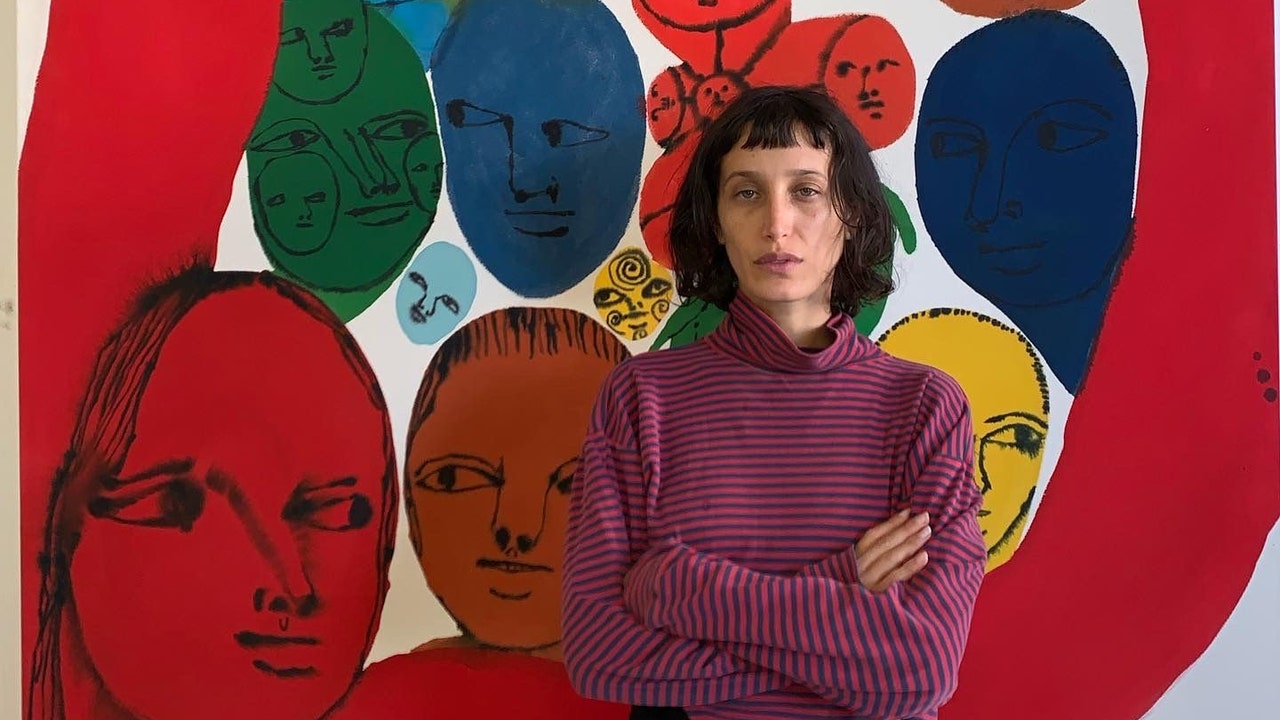Within the whitewashed room that backdrops Emma Kohlmann’s new exhibition, watercolors of warped, acrobatic bodies are pinned to the walls like butterfly specimens. Similar figures reappear as paintings on linen, captured within wooden frames that have been etched with fire to feature curlicues, erect penises, and kissing cherubs. Next to them, a powder-white oval features a spectral, bird-like being; nearby hangs a periwinkle blue, dovecote-shaped ceramic ready to lure any winged creature in.
As sounds from the natural world assembled by Kohlmann’s collaborator Sean Duram play in the background, it is easy to feel transported to the enchanted forest of a Brothers Grimm fairy tale. Only for a minute, though, as Kohlmann’s exhibition, titled “Glowing in the Dark,” is currently being staged at the Jack Hanley Gallery on the Lower East Side, where the very real shadow of a city still living under the restrictions of the pandemic is only steps away.
Sleeping in an Apocalypse, 2020
Courtesy of Jack Hanley GalleryThis feeling of zen—even after it’s been pushed through Kohlmann’s delightfully weird, misshapen filter—wasn’t necessarily what the artist initially had in mind when she first began thinking about the exhibition a year ago. “It was originally planned for April, and then there was so much uncertainty, I wasn’t sure if it was really going to happen,” Kohlmann explains from her studio in rural Massachusetts.
Still, her eclectic range of works more than live up to the glow that the show’s title promises. With the eerie phosphorescence of her signature watercolor technique, her paintings carry both a sense of otherworldliness and a playful, winking humor. “I decided I didn’t want to go through with the same idea when I knew the situation wasn’t going to have changed all that dramatically in terms of COVID,” she adds. “If people are going to go to gallery shows, I want it to be a place where you can come and feel at ease, or have a nice distraction. I hope it can be an oasis of some sort in the city, of pieces that don’t feel so rooted in our world.”
Am I Spiraling April 2020?, 2020
Courtesy of Jack Hanley GallerySharing A Bed Inside My Mind, 2020
Courtesy of Jack Hanley GalleryThe figures that populate Kohlmann’s paintings—which have been used to illustrate numerous Vogue articles in the past—carry all of the strange anthropomorphism of Picasso’s ceramics while adding a more mysterious, genderless top note. “I think looking at work that is rooted in our world can be triggering for some people, especially right now,” she says. “So I like the idea of trying to engage everyone and make it feel egalitarian or inclusive.” It’s a philosophy that applies just as much to her viewer as it does to Kohlmann herself, as she notes that this sense of ambiguity is very much inbuilt. “I always feel inarticulate when it comes to talking about my work, it’s very intuitive for me,” she says. “I can just go into the studio and work on an idea, and just see where that idea goes.”
This take-it-as-it-comes approach not only set Kohlmann in good stead to navigate the challenges she faced when the show was delayed, but also encouraged her to explore new modes of showing her work in the process. “I was actually relieved to have a lot more time to really think about this show,” says Kohlmann. “I liked the idea of creating a space that was more interactive than my usual gallery shows, so I partnered with my friend Sean to make a soundtrack for the space. I made benches, so people could sit down and relax while they’re in the space, and I worked on these frames—I started burning wood during quarantine, just playing around with scraps, and that’s how I came up with the idea.”
Really, however, her hopes for the exhibition are simple: that it can be “meaningful,” as Kohlmann puts it, for anyone looking to take five minutes out of the chaos of the present moment. “I live in a small town on purpose, because I need a lot of alone time to create artwork, but this was very different,” Kohlmann concludes. “I think the constant stream of anxiety about friends getting sick and family getting sick halted things, because it just felt like, what’s the use of art right now? What is the point right now? If there’s collective suffering, how is it going to be useful?” When it comes to the potential for creativity to offer balm to the soul in a moment of crisis, Kohlmann’s is about as useful as art can be.
